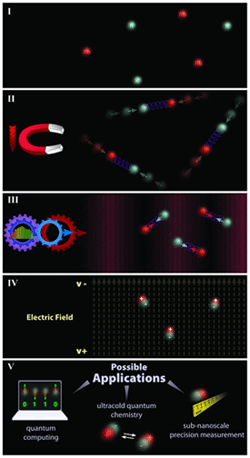BOULDER, Colo., Sept. 18, 2008 – In what could potentially provide breakthrough applications in quantum computing, precision measurement and designer chemistry, scientists at JILA have produced the first high-density gas of ultracold molecules that are both stable and capable of strong interactions.
JILA, a joint institute of the National Institute of Standards and Technology (NIST) and the University of Colorado at Boulder, created the ultracold “polar” molecules that features a positive electric charge at one end and negative charge at the other, which will pave the way for controlled interaction of molecules separated by relatively long distances, potentially leading to new states of matter.
This method, which bonds two different atoms together has been a long-sought milestone in physics.
“Ultracold polar molecules really represent now one of the hottest frontiers in physics,” said NIST/JILA Fellow Jun Ye, an author of the paper. “They are potentially a new form of matter, a quantum gas with strong interactions that vary by direction and that you can control using external tools such as electric fields.”
The scientists say atoms are like basketballs, round and somewhat featureless, whereas molecules are more like footballs, with angles and characteristics that vary by direction.
“This is really a big deal,” said NIST/JILA Fellow Deborah Jin, another author of the new paper. “This is something people have been trying to do for a long time, using all kinds of different approaches.”
An artist’s conception of a gas of ultracold potassium (K) and rubidium (Rb) molecules. The atoms are about 10,000 Bohr radii apart. (One Bohr radius is about 1/20th of a nanometer. Lowering the magnetic field leads to the creation of extremely loosely bound molecules. Atoms in these large, fluffy molecules are about 300 Bohr radii apart.The creation of ground-state polar molecules. Two lasers locked to different lines in the same frequency comb coherently transfer the loosely bound molecules into tightly bound molecules in the low-energy “ground” state.Ground-state polar molecules with a permanent positive charge at the Rb and a permanent negative charge at the K, which means their behavior can be studied and controlled with electric fields. These molecules are in the lowest-energy (ground) state and their atomic nuclei are about 8 Bohr radii apart.Possible future applications of ground-state polar molecules. Because of their potential for strong interactions, ground-state polar molecules could play a role in data processing in quantum computers, controlling reaction rates in ultracold chemistry, and magnifying subnanoscale effects in precision measurement problems. (Photo: G.Kuebler/JILA)
Jin and Ye are adjoint professors of physics at the University of Colorado at Boulder and both teach undergraduate and graduate students. Other authors of the paper include a NIST theorist at the Joint Quantum Institute at the University of Maryland and a theorist at Temple University in Philadelphia.
Two types of atoms are found in nature - fermions, which are made of an odd number of subatomic components (protons and neutrons), and bosons, made of an even number of subatomic components. The JILA group combined potassium and rubidium, which are different classes of atoms (a slightly negative fermion and a slightly positive boson, respectively). The resulting molecules exhibit a permanent and significant differential in electric charge, which, along with the ultracold temperatures and high density, allows the molecules to exert strong forces on each other.
The molecules are in the lowest possible vibrational energy state and are not rotating, so they are relatively stable and easy to control. They also have what is considered a long lifespan for the quantum world, lasting about 30 milliseconds (thousandths of a second).
JILA’s ultracold polar gas has a density of 10 quadrillion molecules per cubic centimeter, a temperature of 350 nanokelvin above absolute zero (about -273 °C or -459 °F), and a measurable separation of electric charge.
The process for making the molecules begins with a gas mixture of very cold potassium and rubidium atoms confined by a laser beam. By sweeping a precisely tuned magnetic field across the atoms, scientists create large, weakly bound molecules containing one atom of each type. This technique was pioneered by Jin in her 2003 demonstration of the world’s first Fermi pair condensate.
At this stage the molecules are very large and possess a high amount of internal energy, which allows them to decay and heat up rapidly, both undesirable effects for practical applications. The scientists faced the considerable challenge of efficiently converting atoms that are far apart into tightly bound molecules, without allowing the released binding energy to heat the gas.
In a process that Jin describes as “chemistry without explosions,” scientists used two lasers operating at different frequencies -- each resonating with a different energy jump in the molecules -- to convert the binding energy into light instead of heat. The molecules absorb near-infrared laser light and release red light. In the process, more than 80 percent of the molecules are converted, through an intermediate energy state, to the lowest and most stable energy level.
A key to success was the development of detailed theory for the potassiumrubidium molecule’s energy states to identify the appropriate intermediate state and select the laser colors for optimal control. In addition, both lasers were locked to an optical frequency comb, a precise measurement tool invented in part at NIST and JILA, synchronizing the two signals perfectly.
The research described is part of a larger NIST/JILA effort to develop techniques to understand and control the complex features of molecules and their interactions.
JILA researchers are now working to improve the efficiency of producing tightly bound polar molecules and extend molecule lifetimes. They also plan to apply the new molecules to explore new scientific directions.
The research was supported by the National Science Foundation, NIST, Air Force Office of Scientific Research and W.M. Keck Foundation.
For more information, visit: jilawww.colorado.edu